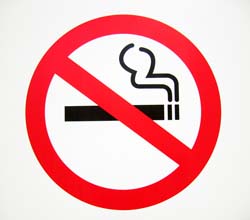Cause and effect
 A recent 12-year longitudinal study on health behavior changes by the Health Analysis Division at Statistics Canada reveals some disturbing trends. This study examined habits regarding smoking, physical activity, alcohol consumption, and diet (fruit and vegetable consumption) among 5,404 Canadians. The subjects were 50 years or older and were studied after they received an initial diagnosis of chronic illness (heart disease, cancer, stroke, respiratory disease, and diabetes). The results showed that even after being diagnosed with a disease condition, and after being counseled by a health care professional on lifestyle modifications to change their condition, most people did not make major lifestyle adjustments to alter their condition.
A recent 12-year longitudinal study on health behavior changes by the Health Analysis Division at Statistics Canada reveals some disturbing trends. This study examined habits regarding smoking, physical activity, alcohol consumption, and diet (fruit and vegetable consumption) among 5,404 Canadians. The subjects were 50 years or older and were studied after they received an initial diagnosis of chronic illness (heart disease, cancer, stroke, respiratory disease, and diabetes). The results showed that even after being diagnosed with a disease condition, and after being counseled by a health care professional on lifestyle modifications to change their condition, most people did not make major lifestyle adjustments to alter their condition.
Smoking was the most commonly reported successful behavior change for those smokers diagnosed with heart disease, diabetes, cancer, or stroke. Surprisingly, those diagnosed with respiratory disease were the exception—not only were they more likely to smoke before diagnosis (25 percent), there was no significant decrease in the percentage who continued to smoke after diagnosis.
The pre-to-post diagnosis for behavior changes in alcohol consumption, physical activity, and fruit and vegetable consumption were depressingly disappointing. Despite professional counseling regarding behavior modification, people did not make significant changes even after a positive diagnosis of disease.
Confronting change
It seems to me there are multiple, interrelated reasons behavior change is so difficult. First, we all live in a world of delusion. We rarely believe what we do will be the cause of our death—until it happens, of course. Mickey Mantle, the great New York Yankee Hall of Famer who ultimately died from liver disease from years of drinking, reportedly said on his death bed, “If I knew I was going to live this long I would have taken better care of myself.”
Most of us don’t want to confront the fact that what we do really matters, until it’s too late.
As we get older, what we do and how we live often define us. Thus, if we have to make a change in how we live, it often means changing what we consider to be our uniqueness. Changing a lifestyle habit often means having to change social circles and activities. Changing behaviors often means trying something new and different, and this has proven difficult for most people.
How we change
 Lifestyle behavior changes occur in one of two ways: something you do (conscious behavior change) or something done to you (injury, forced change in surroundings, etc.).
Lifestyle behavior changes occur in one of two ways: something you do (conscious behavior change) or something done to you (injury, forced change in surroundings, etc.).
Conscious behavior change is a process. It involves specific steps that require time to master. There are new skills to learn like cooking and eating different foods, engaging in new and different physical activities, or even changing sleeping habits. Often, once these skills are learned it takes additional time to integrate them into permanent behavior patterns.
Steps to changing behavior
One popular model of behavior change proposes five stages everyone experiences when adopting new lifestyle behaviors.
- Precontemplation—In this stage you have no “real” intent on changing behaviors. However, you know something is amiss, but you’re not sure what it is or what specifically to do. Often you experience anxiety, discomfort, or problems that bother you. At this stage, change is hypothetical.
- Contemplation—In this stage you “get it.” Something is wrong and you want to know what it is, but you’re not ready to do anything about it. You engage in self-talk, but you are indecisive at this point.
- Preparation—In this stage you want to do something. You’ve had it; you’re not happy. You gather information by talking to others, seeking information online, or getting a professional diagnosis. You might be scared and sometimes you rehearse what you need to do (think “New Year’s Resolution”). At this point you may or not share your decision.
- Action—Here you go! You dive in and really do something. You become committed and begin to work hard. You join a group, seek professional help, or engage a trusted friend or significant other to help you. This stage may take a long time as you learn and practice new behavior skills. In this stage you are likely to experience the ups and downs of success and failure.
- Maintenance—During this stage you’re locked in. Research suggests that as little as six weeks of success can reinforce behaviors that have real potential of becoming permanent.
Skills of successful changers
 People who study behavior change recognize several skills that successful changers possess.
People who study behavior change recognize several skills that successful changers possess.
Successful changers maintain a singular focus on success. They don’t engage in self-doubt. They avoid individuals and activities that might sabotage their efforts.
Successful changers show a quality of persistence. Making changes often means taking two steps forward, one step back. At least the trajectory is in the right direction. Persistence pays off.
Successful changers know and practice change all the time. Changing means practicing all the time, not just on the weekends. Changing behaviors means being committed for the long haul because we know new behaviors can change lives forever.
The Katch 30-Day Health Yourself Nutrition Pledge
Take my 30-day pledge as a way to practice healthy nutrition behavior changes. Keep records in the form of a blog, diary, notes, etc. Detailing your efforts each day will help you practice correctly. Keeping note also encourages persistence.
At the end of the day, reflect on your feelings for a few moments. Think about the obstacles you faced and the insights you gained. Identify ways to ensure lasting success. It’s also a good idea to keep records of your sleeping pattern, your body weight, your mood, your digestion, your perception of self, and/or any other aspect of self that will motivate you toward successful change.
Can you do it?
Try at least one to three of the following good-eating pledges. Of course you can pledge to do as many as you wish. Spend 30 days putting these pledge(s) into practice.
1. I pledge to drink zero soda pop (soft drinks or processed juices).
2. I pledge to eat zero meat (red meat, poultry, fish).
3. I pledge to cut out all red meat and poultry from my diet (fish is OK) for at least three out of seven days of each week.
4. I pledge to eat zero dairy products.
5. I pledge to cut out all dairy products from my diet for at least three out of seven days of each week.
6. I pledge to eat a quality breakfast every day.
7. I pledge to eat nothing out of a bag, can, bottle, or package that has more than seven listed ingredients.
8. I pledge to eat zero refined sweeteners such as sugar, any form of corn syrup, cane juice, or the artificial stuff like Splenda, etc.
9. I pledge to eat zero deep-fried foods.
10. I pledge to eat zero refined grains such as white flour or white rice. (Items containing wheat must say whole wheat, not just wheat.)
11. I pledge to drink zero caffeinated beverages.
12. I pledge to drink no more than one caffeinated beverage per day.
13. I pledge to drink zero alcoholic beverages.
14. I pledge to drink no more than one glass of wine per day.
15. I pledge to avoid eating at any fast-food restaurant.
16. I pledge to avoid eating any packaged sugary snacks. Instead, I pledge to eat fresh fruits, vegetables, whole nuts, or popcorn (without butter).
17. I pledge to try a minimum of three new foods (vegetables, fruits, spices, recipes) per week for a total of 12 new foods.
18. I pledge to eat vegan at least three or more days per week.
19. I pledge to prepare at least one new main course per week.
Post your comments and suggestions below regarding progress with some of the nutrition pledges. Perhaps you can inspire other “Health Yourself” readers to follow your example and start the change.
References:
• Newson, JT et al. 2012. “Health Behaviour Changes after Diagnosis of Chronic Illness among Canadians Aged 50 or Older.” Component of Statistics Canada Catalogue no. 82-003-X. Health Reports
• Prochaska, JO; et al. 1994 “Changing For Good: the Revolutionary Program that Explains the Six Stages of Change and Teaches You How to Free Yourself From Bad Habits.” New York: W. Morrow.




Margaret Wagner - 1986
I believe this article and research completely missed the main issue. This is the problem: at the moment of desiring something, the discomfort of not having it far exceeds any attempt at being healthy or cautious. Whatever it’s called — compulsion, addiction — it’s not about deciding to make a habit change, it’s about being able to endure the very intense negative state at the time. A compulsive eater who wants a piece of cake and a non-compulsive eater who wants one experience totally different feelings if they don’t have it. This is the problem that needs to be solved.
Reply
Howard Cloth
In September 2010, at the urging of my primary care physician, I joined a four-month wellness and nutrition group he and a licensed dietitian in his practice were conducting. They had been leading them since the fall of 2009. I was willing but skeptical—nothing I’d tried over the past 50+ years of my adulthood ever worked (or worked for very long). I was mostly a “couch-potato” with issues relating to high blood pressure, cholesterol, and glycemic index. I was pre-diabetic and my BMI was at the upper range of the “obese” segment.
The results were transformative. Over the ensuing 12 months, I lost almost 20% of my body weight—about 35 lbs.—and eight inches in my waist. I’m also healthier and in better shape by far than in decades, if not ‘ever.’ I Nordic-walk between 20-30 miles per week at a sustained 15-min/mile pace. I also do strength/resistance exercises at the gym twice a week. I sleep like a babe and my mood is generally ‘happy’ in the sense of being content. My diet now emphasizes fruits, veggies, and other nutritionally “dense” foods. At my annual physical in the spring of 2011, my doctor informed me all my test results were normal…and I have been able to maintain these lifestyle changes. Oh, and I should mention I turned 71 last October.
Yes, it’s all about changing one’s behavior—substituting a good behavior for a bad one—but my guess is it’s exceedingly difficult to do it alone, without support for those similarly situated. Here’s my “10 for Change”:
1. Be open to the possibility of success.
• That the change you are making will work vs. unconsciously looking to
i. validate the past (that nothing like this has ever worked for you)
ii. undermine the present (that this approach is/will be no different)
iii. find some comfort in a hopeless future (that you are “hard-wired†to be the way you are).
2. You can’t change what you don’t measure.
• There’s a reason you _____ [fill in the blank]: It feels good! Habits are formed when a behavior is linked to an emotion. Figure your trigger. Try keeping a diary to track exactly what emotion or event triggers a habit, and at what time of day. Also, keep track of your path toward your goals: your weigh-ins, when you exercise and how you progress.
3. Merely knowing about something doesn’t change anything.
4. Changing your behavior requires action.
• People don’t really break habits; they just replace them. So, to break a bad habit, find a new, healthy one to replace it. Eat an apple, not a bunch of cookies. Repeating a healthy behavior is the best way to rewire the brain.
5. Changing your behavior involves planning.
• Anticipate; also, recognize that the immediate reward you get from the bad habit can be stronger than the delayed gratification that comes from kicking it. Successfully kicking a habit means retraining your mind to think not of instant gratification, but of future benefits.
6. Accountability supports change.
• Knowing you will need to be “publically” responsible for your behavior reinforces your efforts toward positive changes.
7. Ask for support—and offer it.
• Encouragement reinforces positive changes.
8. Give change time to show results.
• A fresh, new habit can be easy for two weeks. Then boredom sets in, as does the temptation to backslide. After three weeks, or 21 days, the new habit should become second nature.
9. Allow for lapses.
• Don’t let setbacks provide an excuse to abandon your plan. See these as mere lapses. Swing back into the new habit.
10. Pay it forward.
Reply
Tom Williams - 1980
Following a diet like this is almost impossible unless one buys into the need for it. Without the education and belief of the cause/benefit one cannot be convinced of the need for change.
The diet is similar to that outlined in “Eat to Live”, by Dr. Joel Fuhrman, and in his similar PBS shows (during donation sweeps). In particular, the materials define the effects and benefits of various food types as well as extensive references research studies – all in easy to understand terms.
I always enjoyed the material, but never followed it much until an annual check-up showed high blood pressure. After 3 follow-up visits at 2 month intervals showed the high BP was not an anomaly, the next 2 months more or less followed the diet here, and my BP has since dropped dramatically, and is more like when I was very young. No BP meds needed and additionally on the path to reversing the likelihood of future conditions as for those in the study group the diet “principles” here more or less intended to address.
Another idea of the “principles”, might be to include 2 days (in a row) of “fasting” (gals 400 to 500 cals/day; guys 500 to 600 cals per day) – basically 1 low-cal meal each day for 2 days each week. This was presented in a PBS special my Michael Mosley, “Eat, Fast and Live Longe” (without disease). That supposedly puts the body into “repair” mode by giving the liver a rest from IGF-1 production. Excess IGF-1 keeps the body in “Go-Go” mode, driving cells to multiply and grow. During the “rest days”, cellular repair occurs as well as brain cell neuron growth.
Reply